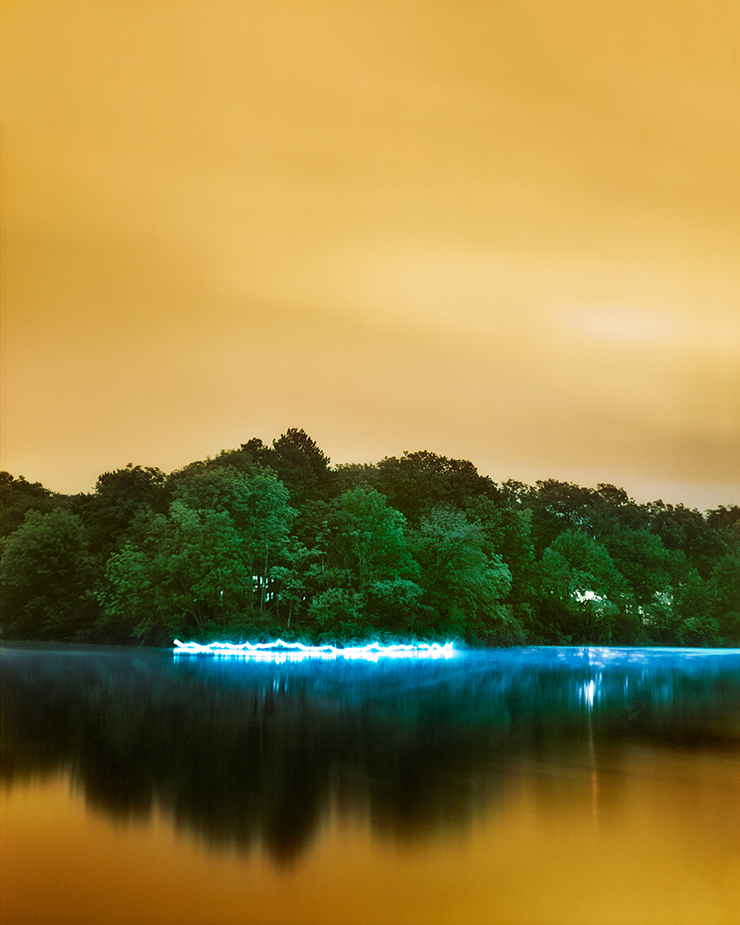
Known for his haunting long-exposure photographic images, Barry Underwood uses light, color and geometry to explore human impact on the environment. “I get the tag ‘light photographer’ or ‘light graffiti artist.’ I hate that,” says Underwood. “It’s a label that doesn’t accurately describe what’s going on.” Viewers will be able to judge the minimalist work for themselves come February 16, when the artist opens his solo show at New York’s Sous Les Etoiles Gallery.
Lily Kwong: What was the first piece you ever created?
Barry Underwood: I made a drawing in 2001 and set the piece up in 2002. It was a series of drawings I’d made that were a combination of optical illusion and constructed imagery. I utilized skills from my undergrad experience designing and building sets.
LK: Where does your process begin?
BU: The drawing process is a big part of it and the installation part is like setting up for a party, in a way. You set up all day and right before the people show up for the party, you turn the lights on and there’s a brief moment of excited expectation and quiet reflection. And then I ship off the film and when I get it back, I sit in front of the computer for a long time cleaning up the image. Finally there’s the framing process and seeing it in the gallery. I think about construction all throughout the process.

LK: Why do you work in-camera vs. in-post?
BU: I get the tag ‘light photographer’ or ‘light graffiti artist’ - I hate that. It’s a label that doesn’t accurately describe what’s going on. You can tell when light is more CG as opposed to naturally blended into the landscape.
LK: And you still prefer film?
BU: It’s getting to the point where the dynamic range with digital is getting better and better, but I like that long slow burn. You start working with reciprocity failure, where there is a little bit of a color shift with film. I also like that meditative state of working with a slower process.
LK: Some of your exposures take up to 6 hours - how do you spend that time?
BU: If a friend is with me helping set up, we’ll just have a conversation. I’ve sat out there and watched movies - one summer I watched 100 episodes of the X-files.
LK: Funny you mention that because some of your works feels as if it were influenced by extraterrestrials
BU: Sure there’s a sci-fi aspect to the work. I was a big Star Wars geek when I was a kid, and I like Close Encounters of the Third Kind.
LK: Those films are really concerned with light composition. How do approach that in your work?
BU: It’s usually reflecting a mark that humans are making within the field. It could be star streaks blended with an airplane. A car going through the woods. I’m always trying to find a space that has some light activity in the background that often gets overlooked.

LK: Your artist statement says: “Landscape can reflect one’s own self-definition.” What do you mean by that?
BU: Actual geography gets constructed into social geography. A developer might see a field and think it would be a good place for a housing development. A farmer might think the same place is good for growing crops. There’s a lot of that kind of demarcation in my work.
LK: What do you want people to see in your work?
BU: It’s a little bit of a bait and switch. At first it looks like a pleasant landscape and the lights look intrusive. I shoot on tilted ground quite a bit so it feels a little eerie. I like the way responses can oscillate back and forth. It’s a slower kind of read.I like to think of my work as poetic gestures. Just look at the images like that - like poetry.

LK: Tell me about the work you’ll be showing in New York.
BU: It’s a continuation of the old work, but approached more abstractly. Some of it’s from Wyoming when I was at Teton Art Lab. I made a few pieces in Jackson, Wyoming and around Cleveland.
LK: Over a decade has passed since your first installation - what keeps you coming back to this type of work?
BU: I like the idea of constructing something. A childhood friend and I used to build things in the woods. We’re still like those little kids playing in the woods. The work kind of finds you sometimes.




